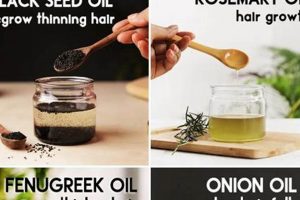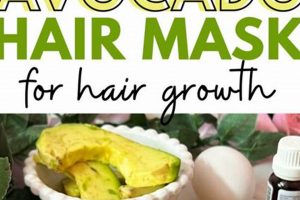The practice of creating a homemade texturizing solution, often involving saline, water, and other additives, allows individuals to craft a product intended to mimic the effects of ocean air on hair. Such solutions aim to enhance wave formation and volume. For instance, an individual might combine sea salt, warm water, and a small amount of hair conditioner to produce a styling aid designed to create a tousled aesthetic.
Formulating such a product offers potential advantages, including cost-effectiveness and control over ingredients. Historically, individuals have sought natural methods for achieving desired hairstyles, and creating personalized styling products represents a continuation of this trend. The ability to select components can allow for avoidance of specific chemicals or allergens, catering to individual sensitivities and preferences.
The following sections will delve into the necessary components, formulation techniques, and potential modifications for crafting such a personalized hair care item, along with considerations regarding safety and optimal application methods.
Crafting a Texturizing Hair Solution
Achieving optimal results when formulating a texturizing hair solution necessitates attention to detail and a methodical approach. The following guidelines serve to enhance the efficacy and safety of such endeavors.
Tip 1: Saline Concentration Management: The proportion of salt to water is a critical factor. Excessive saline can lead to dryness and potential hair damage. Start with a low concentration (approximately 1-2% salt by weight) and incrementally increase as needed, observing hair response over multiple applications.
Tip 2: Incorporating Emollients: Salt, by its nature, can be drying. Integrating a small quantity of a moisturizing agent, such as a lightweight hair conditioner or a non-comedogenic oil (e.g., argan oil, fractionated coconut oil), can mitigate dryness and enhance hair manageability. Ensure thorough mixing to prevent separation.
Tip 3: Distilled Water Utilization: Tap water contains minerals and additives that can negatively impact the final product’s performance and stability. Utilizing distilled water minimizes potential interactions and ensures a purer base for the solution.
Tip 4: Preservative Considerations: Homemade formulations lack the robust preservation systems of commercially manufactured products. While optional for short-term use (within 1-2 weeks), incorporating a broad-spectrum preservative, particularly if oils or extracts are included, can inhibit microbial growth and extend shelf life. Adhere strictly to the manufacturer’s recommended usage rates.
Tip 5: Fragrance Incorporation (Optional): If desired, add a few drops of essential oil for fragrance. However, some essential oils can be photosensitizing or irritating. Conduct a patch test on a small area of skin before applying to the entire head. Consider using pre-blended fragrance oils designed for cosmetic use.
Tip 6: Solution Homogenization: Thoroughly agitate the mixture before each use. This ensures even distribution of ingredients and prevents inconsistencies in application. A spray bottle with a built-in agitator is advantageous.
Tip 7: Application Technique Refinement: Apply the solution sparingly to damp hair, focusing on the mid-lengths and ends. Avoid saturating the roots, as this can lead to a greasy appearance. Scrunch hair gently to encourage wave formation.
These guidelines emphasize the importance of careful formulation and application. By adhering to these principles, individuals can enhance the effectiveness and minimize potential adverse effects associated with creating a homemade texturizing solution.
The subsequent sections will address advanced formulation techniques and provide detailed instructions on creating specific variations of the texturizing solution tailored to different hair types and styling preferences.
1. Saline Concentration
Saline concentration represents a foundational element in the formulation of homemade texturizing hair solutions. Its precise modulation dictates the efficacy and potential impact on hair health, warranting careful consideration.
- Texturization Efficacy
The percentage of salt dissolved in the aqueous solution directly correlates with the level of texturization achieved. Higher saline concentrations tend to create more pronounced waves and a coarser texture, mimicking the effect of exposure to seawater. However, exceeding an optimal concentration threshold can lead to excessive dryness and brittleness.
- Osmotic Balance
The principle of osmosis plays a crucial role. Highly concentrated saline solutions draw moisture out of the hair shaft, resulting in a temporary alteration of its structure. While this contributes to the desired texturizing effect, prolonged or excessive exposure can disrupt the natural moisture balance, leading to dehydration and potential damage.
- Scalp Sensitivity
Elevated saline levels can irritate the scalp, particularly in individuals with pre-existing sensitivities or conditions such as eczema or psoriasis. The solution’s ionic strength can disrupt the skin’s natural barrier function, potentially causing redness, itching, and flaking. Dilution and patch testing are advisable to mitigate these risks.
- Hair Type Considerations
The ideal saline concentration varies depending on hair type. Fine or thin hair may require a lower concentration to avoid weighing it down, while thick or coarse hair may tolerate a higher concentration for optimal texturization. Experimentation and observation are essential to determine the appropriate balance for individual needs.
In conclusion, the selection of an appropriate saline concentration is paramount in the creation of texturizing hair solutions. A delicate balance must be struck between achieving the desired aesthetic effect and preserving hair health. Careful consideration of osmotic principles, scalp sensitivity, and hair type is crucial for optimal and safe application.
2. Ingredient Selection
Ingredient selection is a critical determinant of the efficacy and overall quality of a homemade texturizing hair solution. The composition of the solution directly influences its ability to impart the desired texture, volume, and hold, while simultaneously impacting hair health and manageability. For example, the type of salt used (sea salt vs. Epsom salt) affects the mineral content of the solution, potentially impacting hair strength and shine. Similarly, the addition of humectants, such as glycerin or aloe vera, can counteract the drying effects of salt, preventing excessive brittleness. The absence or presence of specific ingredients thus triggers a cascade of effects, shaping the final product’s performance.
Beyond the primary texturizing agent (salt), the inclusion of complementary ingredients enhances the solution’s functionality. Oils, such as argan or coconut oil, can provide lubrication and reduce frizz, while hair conditioners or detanglers improve manageability and ease of combing. Botanical extracts, such as seaweed extract, may offer additional moisturizing or strengthening benefits. Failure to carefully consider these supplemental components can result in a product that is either ineffective in achieving the desired texture or detrimental to the hair’s overall health. A solution consisting solely of salt and water, for instance, may effectively texturize the hair but leave it feeling dry, brittle, and prone to breakage.
In summation, informed ingredient selection is paramount to the successful creation of a homemade texturizing hair solution. A thorough understanding of the individual properties of each component, their interactions, and their potential impact on hair health is essential. By carefully curating the solution’s composition, individuals can craft a personalized styling aid that effectively achieves the desired aesthetic while minimizing potential negative consequences. The key challenge lies in striking a delicate balance between texturizing efficacy and hair health, a balance that is ultimately achieved through mindful ingredient selection.
3. Mixing Technique
The process of blending components during the formulation of homemade texturizing hair solutions is a critical determinant of product efficacy and consistency. Improper mixing can lead to ingredient separation, uneven distribution of active compounds, and ultimately, a suboptimal styling outcome.
- Solubility Enhancement
The order and method of combining ingredients directly impact their solubility. Introducing salt to warm water, for instance, facilitates dissolution compared to cold water, preventing undissolved particles that can affect spray nozzle function or create an uneven texture on the hair. Vigorous stirring or agitation ensures complete saturation of the saline solution.
- Emulsion Stability
When incorporating oils or conditioners, the mixing technique affects emulsion stability. Insufficient agitation can lead to phase separation, resulting in an inconsistent spray and reduced moisturizing effect. Employing an emulsifier or utilizing a high-shear mixer can enhance emulsion formation, ensuring uniform distribution of oil droplets within the aqueous phase.
- Preservative Distribution
For formulations incorporating preservatives, thorough mixing is essential for uniform distribution throughout the solution. Inadequate mixing can result in localized microbial growth, compromising product safety and shelf life. A magnetic stirrer or prolonged manual agitation can ensure that the preservative effectively protects the entire formulation.
- Fragrance Integration
The method of adding fragrance oils or essential oils influences their integration into the solution. Introducing these volatile compounds gradually while stirring minimizes evaporation and ensures even dispersion, preventing localized concentrations that could cause irritation or allergic reactions.
In summary, the mixing technique employed during the formulation of homemade texturizing hair solutions significantly impacts product performance, stability, and safety. Attention to detail in this process, encompassing solubility enhancement, emulsion stability, preservative distribution, and fragrance integration, is crucial for achieving a consistently effective and safe styling aid.
4. Application Method
The application method fundamentally dictates the final aesthetic achieved with a homemade texturizing hair solution. Variances in technique directly influence wave formation, volume, and overall style, highlighting the inextricable link between product and process.
- Hair Dampness Level
Application to excessively wet hair dilutes the solution, diminishing its texturizing capabilities. Conversely, application to completely dry hair can result in uneven distribution and a stiff, unnatural appearance. Damp hair provides the optimal surface for the solution to adhere and create the desired wave pattern without excessive product saturation.
- Spraying Technique
A targeted spray, focusing on mid-lengths to ends, prevents product buildup at the roots, which can lead to a greasy appearance. Holding the spray bottle at a distance allows for even distribution, minimizing concentrated deposits. Techniques such as scrunching or twisting hair after spraying enhance wave formation and volume.
- Sectioning and Layering
Applying the solution in sections ensures uniform coverage, particularly for individuals with thick hair. Layering the solution allows for building texture gradually, preventing over-application and stiffness. This controlled approach is essential for achieving a natural, tousled look.
- Post-Application Manipulation
After application, techniques such as air-drying, diffusing, or using a curling iron to enhance specific sections further influence the final style. Air-drying promotes a more relaxed wave pattern, while diffusing provides increased volume and definition. Targeted use of a curling iron allows for accentuating specific strands or waves.
These facets illustrate the crucial role of application method in realizing the full potential of texturizing hair solutions. Mastery of these techniques allows individuals to tailor the product’s effects to their specific hair type and desired style, emphasizing the synergistic relationship between formulation and application.
5. Storage Protocols
The longevity and safety of a homemade texturizing hair solution are intrinsically linked to adherence to appropriate storage protocols. Improper storage can lead to microbial contamination, ingredient degradation, and subsequent ineffectiveness or potential harm. The absence of robust preservatives in homemade formulations, characteristic of commercially produced alternatives, necessitates stringent attention to storage conditions. As an illustration, a solution stored in a warm, humid environment fosters microbial growth, evidenced by changes in odor, color, or texture. The consequence of using such a contaminated product can range from scalp irritation to more severe infections. Therefore, understanding and implementing proper storage methods is not merely a precautionary measure but a fundamental component of responsible formulation and use.
Specific storage protocols should encompass several key considerations. Opting for airtight, opaque containers minimizes exposure to air and light, both of which can degrade certain ingredients, such as essential oils or botanical extracts. Refrigeration, where feasible, significantly retards microbial proliferation and preserves the integrity of the solution over an extended period. Labeling each batch with the date of creation allows for tracking its age and facilitates timely disposal before potential spoilage occurs. Furthermore, avoiding cross-contamination by using clean equipment and dispensing methods is essential. For example, reusing a spray bottle previously containing a different product without thorough sterilization can introduce unwanted microorganisms or chemicals into the texturizing solution, compromising its purity and safety.
In summation, the implementation of meticulous storage protocols is paramount to ensuring the safety, efficacy, and longevity of homemade texturizing hair solutions. Deviation from recommended practices can lead to product degradation, microbial contamination, and potential adverse effects. Therefore, understanding and adhering to proper storage techniques should be regarded as an indispensable facet of the formulation process, safeguarding the user’s health and maximizing the product’s intended benefits.
Frequently Asked Questions
The following section addresses common inquiries regarding the formulation and utilization of texturizing hair solutions, providing detailed answers to enhance understanding and promote safe practices.
Question 1: What is the expected shelf life of a homemade texturizing hair solution?
The shelf life is contingent upon storage conditions and the inclusion of preservatives. A solution composed solely of salt and water, stored in a cool, dark environment, may remain viable for approximately 1-2 weeks. The addition of oils or botanical extracts necessitates refrigeration and may benefit from the inclusion of a broad-spectrum preservative, potentially extending shelf life to 1-2 months. Observe for any changes in odor, color, or texture, which indicate spoilage.
Question 2: Can this solution be used on color-treated hair?
The impact on color-treated hair varies depending on the formulation and the individual’s hair. High saline concentrations can potentially contribute to color fading or dryness. It is advisable to conduct a strand test before applying the solution to the entire head. Employing a lower saline concentration and incorporating moisturizing ingredients can mitigate potential adverse effects.
Question 3: What is the appropriate saline concentration for fine hair?
Fine hair generally requires a lower saline concentration to prevent weighing it down or causing stiffness. A starting concentration of 0.5% to 1% salt by weight is recommended. Observe the hair’s response and adjust the concentration accordingly. Excessive salt can lead to limpness and lack of volume.
Question 4: Are there any contraindications for individuals with scalp conditions?
Individuals with scalp conditions such as eczema, psoriasis, or seborrheic dermatitis should exercise caution. High saline concentrations can exacerbate irritation and inflammation. It is advisable to consult with a dermatologist before using a texturizing hair solution. Alternative styling methods may be more suitable.
Question 5: How frequently can this solution be used without causing damage?
Frequency of use depends on individual hair type and formulation. Daily use of high-saline solutions can lead to dryness, brittleness, and damage. Limiting use to 2-3 times per week and incorporating moisturizing ingredients can help mitigate these effects. Observe the hair for signs of dryness or breakage and adjust frequency accordingly.
Question 6: Can essential oils be added for fragrance, and if so, which ones are recommended?
Essential oils can be added for fragrance, but caution is advised. Some essential oils can be photosensitizing or irritating. Lavender, chamomile, and rosemary essential oils are generally considered safe for hair and scalp use. Conduct a patch test before applying to the entire head. Limit concentration to 1% or less to minimize potential adverse reactions.
These answers provide a comprehensive overview of common concerns related to texturizing hair solutions, emphasizing the importance of informed practices and individual hair considerations.
The subsequent section will provide details regarding ingredient alternatives, exploring various options for customizing the formulation based on specific hair needs and preferences.
Concluding Remarks
The exploration of “hair salt spray diy” has revealed a nuanced practice involving careful ingredient selection, precise mixing techniques, and strategic application methods. Optimal outcomes hinge upon understanding saline concentration’s impact, considering storage protocols, and tailoring formulations to individual hair types. This approach ensures effectiveness while minimizing potential adverse effects.
The responsible and informed creation of such solutions demands vigilance and a commitment to ongoing evaluation. As individuals engage in this practice, they must prioritize hair health and safety above all else, continually adapting their methods based on observation and experience. The future of personalized hair care lies in the conscientious application of knowledge and a dedication to refining techniques for optimal results.







